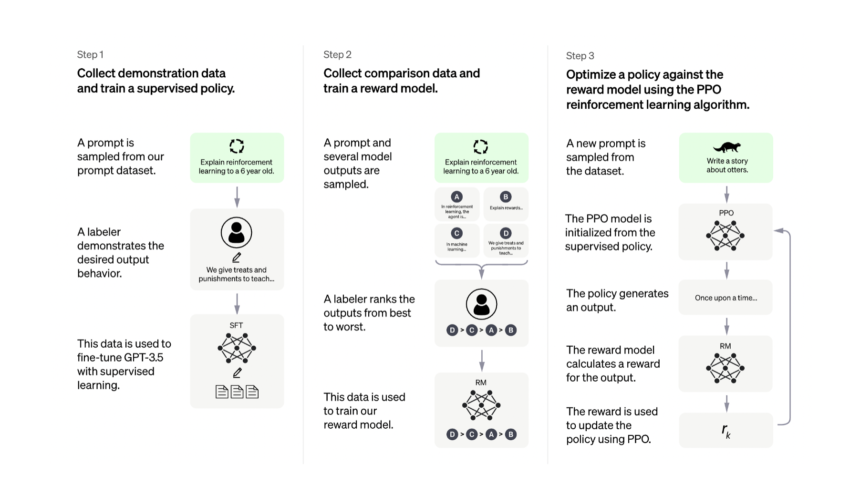Introduction to ChatGPT-4 vs Bard AI
Open AI’s release of ChatGPT in November 2022 turned the artificial intelligence (AI) laboratory into a household name. The lab that had previously only been known to insiders became the subject of everyday conversations because of the capabilities and limitations of its chatbot.
But OpenAI was not the only team working on language-based AI technology applications. Another household name, Google, soon countered with its own application, Google Bard. Despite its big name, Bard has not yet made the same impact as ChatGPT, but it is starting to gain a following.
ChatGPT-4 and Bard AI are both advanced AI language models designed to generate human-like text based on given prompts. While ChatGPT-4, developed by OpenAI, is based on the GPT-4 architecture, Bard AI is a separate AI model developed by Google. Both models have been trained on vast amounts of text data and are capable of producing coherent, contextually relevant responses to a wide range of queries. They are utilized in various applications such as content generation, question-answering, and natural language understanding.
One key difference is Bard AI pulls information from real time data unlike ChatGPT-4 which works on data as of Sept 2021. This gives Bard AI a distinct advantage over ChatGPT-4. Although ChatGPT-4 holds a lot more context as you use it than Bard AI.
However, there might be differences in their architecture, training data, and approach to language modeling, which could lead to variations in the quality, consistency, and relevance of their outputs. Here is a closer look at both systems, comparing key features, benefits, and limitations.
Historical Development and Evolution
Before we look at how both systems work and why they may be a good choice for you and your business, it is worth considering their pedigree and their development.
ChatGPT4
OpenAI launched ChatGPT in November 2022 and had one million active users within less than a week. There is no doubt that this AI-powered chatbot made an impression reaching far beyond the tech industry. The GPT language model and its capabilities in terms of answering natural language questions not only became the subject of everyday conversations.
The tool was also among the first to inspire individuals outside the industry to embrace or at least try what chatbots could do. Trained on human-created text sourced online, Open AI’s model uses an approach known as GPT (generative pre-trained transformer) architecture. The initial model performed so well that teachers and professors became concerned it would be able to produce academic essays and other assignments.
Since then, some of the model’s limitations have become obvious. At the same time, OpenAI’s engineers have worked to rectify them and improve the model overall. The result is OpenAI’s tweaked GPT-4 model. Launched in March 2023, it is an example of even more advanced deep learning techniques using generative AI.
Bard AI
Google responded to the release of ChatGPT with its own experimental version of a chatbot based on generative AI – Google Bard. Bard was released in February 2023. Compared to the Google search engine, Bard delivers higher-quality answers to questions asked by users.
Initially only available to beta testers, it is now accessible to the general public through a waiting list. Bard has not been without its problems since the software was first launched. During an early demonstration, it generated a wrong answer that quickly went viral and cost parent company Google about $100 billion in stock value.
Bard vs. ChatGPT: What’s the difference?
When comparing AI language models like ChatGPT-4 and Bard AI, it is essential to consider several factors, such as the accuracy, coherence, and creativity of the generated text. Additionally, the ability of the models to maintain context and generate responses that adhere to ethical guidelines is also crucial. While both models have their strengths and limitations, users should consider their specific needs and requirements when choosing between the two. As AI language models continue to evolve and improve, it is expected that future iterations of these models will offer even more advanced capabilities and refined performance, further enhancing their applicability across a wide range of industries and use cases.
There are two major differences between these AI-powered chatbots. The first technical difference is the data source the chatbot’s answers are based on. The second difference lies in the language model parameters that conversations use.
ChatGPT-4 uses – GPT – Generative Pre-Trained Transformer. (Transformer-based neural language models)
Bard AI uses – LaMDA – Language Model for Dialogue Applications.
Core Technologies and Architectures
What is behind ChatGPT-4
ChatGPT-4 is built on a natural language processing model known as a generative pre-trained transformer. Its answers are based on a training database that covers 2021 and before. That limits its knowledge sets. For users of the underlying GPT model, it means the software may struggle to provide accurate responses to questions covering more recent events or data.
Source : OpenAI
What is behind Bard AI
Bard AI was created first and foremost to integrate with Google search and enhance the answers users received to their natural language queries.
Bard uses Google LaMDA – short for Language Model for Dialogue Applications. Its initial version required significant amounts of computing power, but a recently released second version is lighter and easier to handle queries for a wide range of users.
Bard AI is basing its answers on real-time information from the internet, allowing it to provide solid responses for more recent events or questions.

Source: https://blog.google/technology/ai/lamda/
Natural Language Processing Capabilities
Both chatbots deliver natural language answers to natural language questions that are typical for generative AI. Generative AI is capable of producing new content from a range of data sources as opposed to recognizing patterns and analyzing data, which are typical of traditional AI.
In their approach, both aim to provide fully formulated, correct answers rather than simply listing the results of a search function.
ChatGPT4 and NLP
ChatGPT-4, as an advanced AI language model based on the GPT-4 architecture, possesses an extensive range of natural language processing (NLP) capabilities that enable it to understand, interpret, and generate human language with impressive accuracy and coherence. Some of its key NLP capabilities include:
- Sentiment Analysis: ChatGPT-4 can analyze text data to determine the sentiment or emotion behind it, such as positive, negative, or neutral. This capability is particularly useful for businesses that want to monitor customer feedback or analyze social media comments.
- Text Summarization: The model can process and condense lengthy text documents into shorter, coherent summaries, which can be helpful for extracting key information from articles, research papers, or reports.
- Machine Translation: ChatGPT-4 is capable of translating text between multiple languages, enabling more accessible communication between individuals who speak different languages.
- Question-Answering: The model can understand and provide accurate, contextually relevant answers to user queries, making it suitable for creating AI-powered chatbots or virtual assistants.
- Text Generation: ChatGPT-4 excels at generating coherent, contextually appropriate text based on a given prompt, which can be leveraged for content creation, copywriting, and even creative storytelling.
- Named Entity Recognition: The model can identify and classify entities, such as people, organizations, or locations, within a given text, making it useful for tasks like data extraction and organization.
- Part-of-Speech Tagging: ChatGPT-4 can analyze and label the grammatical components of a sentence, such as nouns, verbs, adjectives, and adverbs. This capability is useful for linguistic analysis and other NLP tasks that require an understanding of sentence structure.
These NLP capabilities of ChatGPT-4 enable it to tackle a wide array of applications across various industries, including customer service, content creation, market research, and more, ultimately demonstrating the versatility and power of this advanced AI model.
Bard AI and NLP
When it comes to natural language tasks, Google Bard AI and its LaMDA language model are more focused on creating real, human-like conversations rather than simply providing answers. A simple way to think of Bard is to imagine a supercharged version of Google Assistant that takes the search bar beyond traditional search queries.
Bard’s output is open-ended, whereas ChatGPT conversations are currently limited to 25 turns every 3 hours as of now. LaMDA has also been programmed to understand the user’s intent behind a question as well as apply context to the conversation. The result can be stunning, with users reporting that conversations truly feel like talking to a human.
Also Read: What is NLP?
Creative Writing and Text Generation
The ability of these tools to address complex topics and a wide range of topics is impressive. There are key differences in how these tools operate, let us learn more.
ChatGPT4 and AI-Powered Text and Image Generation Technology
When ChatGPT was launched, the software’s capacity to write anything from social media posts to product descriptions for a variety of products, email drafts, and entire academic essays raised concern across wide sections of society.
Professors feared for the legitimacy of students’ assignments, too. OpenAI replied to those concerns by adding a new text classifier to the underlying GPT model. The addition was completed even before the launch of OpenAI’s tweaked GPT-4 model. There are many tools out there that now can help detect AI generated content or Human generated content. With ChatGPT-4 the ability to ingest image input to help design / code is really impressive.
Bard AI, Human-Like Text, and Creative Writing
Despite its name, Bard’s main goals do not currently include creative writing and composing entire essays. Instead, the tool aims to retrieve information in a simple answer format. In that respect, it resembles personal assistants like Siri or Alexa more than ChatGPT. Bard will also provide links leading to further information on a subject.
Bard is capable of applying different tones, such as sounding diplomatic when questioned about competitor products. In addition, Bard does beat ChatGPT when it comes to mimicking human-like responses and chatbot conversations.
Language Models in Multilingual Contexts
How does either tool perform when we add different languages to the mix? Here is a closer look.
ChatGPT4 and Other Languages
ChatGPT has been trained on data in various languages and is therefore able to process questions and deliver answers in multilingual contexts. Limitations relate to the availability of data.
If there is not enough training material available in a specific language or the software cannot find enough information about a certain country, its answers will be limited. As more data becomes available, and ChatGPT receives more training, these issues will likely disappear.
Bard AI and Other Languages
Google claims that Bard AI is available in 1,000 languages. But not only that – the tool has been designed specifically to empower language minority communities.
With high-level translating capabilities, Bard aims to improve access to information for those who do not speak English. To that end, the tool comes complete with a library of translated audio content and text. Plus, Bard allows users who do not share a language to communicate in real time.




